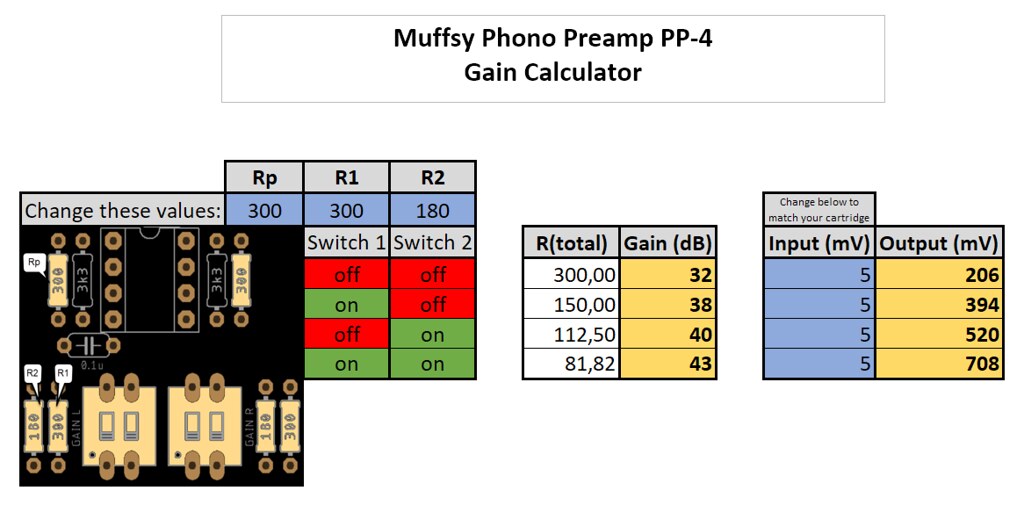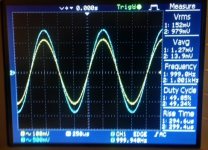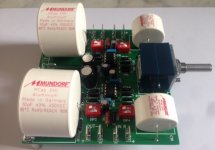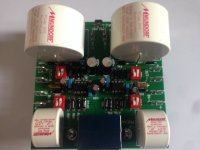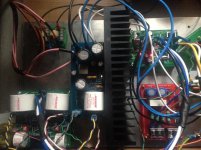yes mistake this is +20db for 50hzThat is not -20dB at 50Hz (Pole#1), 0dB at 1KHz (zero#1), and -20dB around 20KHz (zero #2) ?
Thinking quickly: each gain-stage is gain about 30dB, yes.
The in-between R-C network has loss. How much?
It varies with frequency. According to the RIAA curve.
We usually quote phono preamp gain at 1KHz. This type RIAA R-C network has gain of 0 dB at super low frequency, -3dB at 50Hz, -20dB at 1KHz, and -40dB around 20KHz.
So at 1KHz we have gain of (30dB)+(-20dB)+(30dB), which is 40dB, which is very typical.
Switches in the 2nd stage allow you to trim this up or down as needed to suit your system.
as always, thanks for sharing your knowledge!
would you mind sharing the formula you use to calculate this kind of RIAA network?
thanks!
That is not -20dB at 50Hz (Pole#1), 0dB at 1KHz (zero#1), and -20dB around 20KHz (zero #2) ?
Hicoco,
Here's an Excel calculator for determining the gain:
Muffsy PP-4 Gain Calculator
I've made a screenshot with the default values, shown with two decimals instead of none:
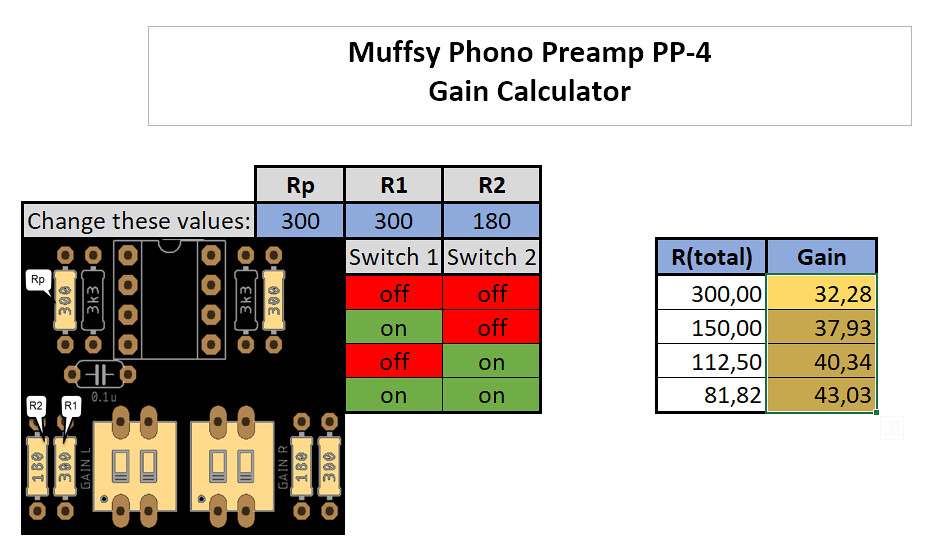
The formula for the 40.34 dB gain is:
20*(LOG(1+(3300/112.5)))+10.7, where 10.7 is the gain of the first stage minus the loss at 1 kHz in the RIAA filter.
And yes, I've measured all four settings and verified that they are correct.
Hicoco,
Here's an Excel calculator for determining the gain:
Muffsy PP-4 Gain Calculator
I've made a screenshot with the default values, shown with two decimals instead of none:
The formula for the 40.34 dB gain is:
20*(LOG(1+(3300/112.5)))+10.7, where 10.7 is the gain of the first stage minus the loss at 1 kHz in the RIAA filter.
And yes, I've measured all four settings and verified that they are correct.
Thanks skrodahl,
Nice calculator, very helpful.
If i understand right you lost almost 12dB in the first stage...
First stage= 20*(LOG(1+(3300/100)))= 30.62dB
Second stage= 20*(LOG(1+(3300/112.5)))= 21.58dB
(30.62 + 21.58)-40.34 = 11.76 dB
Let me know if I'm totally off topic, the thread is about ESP P88...
You've done something wrong when calculating the gain in the second gain stage. Here's the calculation:

Is the filter dampening 19.93 dB at 1 kHz? I just measured it and got to that number, which means it's correct for this circuit using my measuring equipment. (Quant Asylum QA401)
How about mathematically? It's not, as some claim, how much down it is from 20 kHz (in which case the number would have been 19.62 dB), or 0 dB at 1 kHz in a passive filter configuration. The filter has no attenuation at 0 Hz, so we need to know how much down it is from there.
This PDF says it's down -19.911 dB (page 113), so I'm not really that far off.
You've done something wrong when calculating the gain in the second gain stage. Here's the calculation:

Is the filter dampening 19.93 dB at 1 kHz? I just measured it and got to that number, which means it's correct for this circuit using my measuring equipment. (Quant Asylum QA401)
How about mathematically? It's not, as some claim, how much down it is from 20 kHz (in which case the number would have been 19.62 dB), or 0 dB at 1 kHz in a passive filter configuration. The filter has no attenuation at 0 Hz, so we need to know how much down it is from there.
This PDF says it's down -19.911 dB (page 113), so I'm not really that far off.
Last edited:
Oui you are right the second stage is 29.64dB, and the lost is (30.63 + 29.64)-40.34 = 19.93dBLet me know if I'm totally off topic, the thread is about ESP P88...
You've done something wrong when calculating the gain in the second gain stage. Here's the calculation:

Is the filter dampening 19.93 dB at 1 kHz? I just measured it and got to that number, which means it's correct for this circuit using my measuring equipment. (Quant Asylum QA401)
How about mathematically? It's not, as some claim, how much down it is from 20 kHz (in which case the number would have been 19.62 dB), or 0 dB at 1 kHz in a passive filter configuration. The filter has no attenuation at 0 Hz, so we need to know how much down it is from there.
This PDF says it's down -19.911 dB (page 113), so I'm not really that far off.
For sure, here it isNice!
I like your DIP switches, you wouldn't happen to have a part number for them?
76SB02ST
Nice one, I knew it's gonna be professional! Congrats hicoco
A hint for next time. You don't need faston connectors for signal input/output, unless you have a truck load of them and want to finish the stock.
2.54mm pitch molex connectors or 5mm pitch terminal blocks do the job fine.
A hint for next time. You don't need faston connectors for signal input/output, unless you have a truck load of them and want to finish the stock.
2.54mm pitch molex connectors or 5mm pitch terminal blocks do the job fine.
Last edited:
Yes Mixi, this is a very simple Preamp, working perfectly with my little 60W Amp (Lm3886), very happy...no hum, pure tune, like ivanlukic said this is the new p88 Monster with the 2 big Mundorf capnicely done! really nice! how do you like it?
Thanks Prasi...... yes i have a lot of faston terminal connectorsNice one, I knew it's gonna be professional! Congrats hicoco
A hint for next time. You don't need faston connectors for signal input/output, unless you have a truck load of them and want to finish the stock.
2.54mm pitch molex connectors or 5mm pitch terminal blocks do the job fine.
I'm still testing with my test board and with the power supply board for the preamp, the LM317 and LM337 heat up a bit, I'll definitely have to put larger heatsink.at first i though your mundorf caps where overkill. but now i figured most polypropylene caps are rather large (compared to polyester) so why not use the mundorfs. actually i think i might use them as well
do you have a picture of your final setup with power supply?
I am looking also for a Dc speaker protection, may be this one i am not sure.
Mosfet-based replacement for loudspeakers relays
Attachments
Last edited:
So i'm making slow progress with my p88 amp. Currently I'm not sure how to wire the gnd cables and some help would be appreciated. I'm attaching the suggested layout from the ESP site and that's pretty much how my setup will look like (just fewer inputs and only one set of outputs, no tape). Can anyone suggest how to route signal ground between RCA inputs, P06 Phono, Selector Switch , P88 and RCA out?
And what about power ground? I'll run it off a 15VAC wall wart. Am I right to assume that I don't have to make a safety gnd connection to the chassis?
And what about power ground? I'll run it off a 15VAC wall wart. Am I right to assume that I don't have to make a safety gnd connection to the chassis?
An externally hosted image should be here but it was not working when we last tested it.
I made this circuit on protoboard. It's working fine. I'm using 10k log potentiometer, article mentions that this preamp uses linear pot with fake log resistors. Do I need to remove these resistors from protoboard if I decided to use log potentiometer?
If so, which one is it? 15k?
If so, which one is it? 15k?
- Home
- Source & Line
- Analog Line Level
- Rod Elliot Project 88 question
